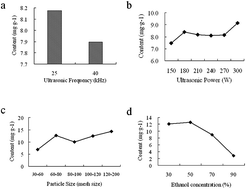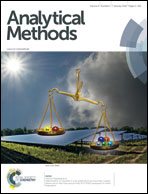Optimisation of the solvent extraction of bioactive compounds from Lophatherum gracile Brongn. using response surface methodology and HPLC-PAD coupled with pre-column antioxidant assay
Abstract
Lophatheri Herba was demonstrated to be rich in flavonoid glycosides, therefore, it is of great importance to explore the high-value utilization. In this regard, these constituents own significant antioxidant capacities to protect the human body from the aforementioned health problems. The aim of the article was to optimize and screen the main antioxidative components in ethanol extraction of Lophatheri Herba. Response surface methodology (RSM) was used for the enhanced recovery of total flavonoid content (TFC), combined with two in vitro methodologies of measuring antioxidant activities, 2,2-di-phenyl-1-picrylhydrazyl (DPPH) free radical-scavenging activity and 2,2′-azinobis (3-ethylbenzothiazoline-6-sulfonic acid) diammonium salt (ABTS) free radical-scavenging activity, and HPLC-PAD coupled with pre-column DPPH assay. Plackett–Burman design and Box-Behnken design (BBD) were employed to optimize the ethanol concentration (x1: 50%), powder particle size (x2: 80–100 mesh) and extraction times (x3: 3 times), obtaining ethanol extracts from Lophatheri Herba with high total flavonoid contents and high antioxidants. Based on the reduced or disappeared HPLC chromatogram peaks of the mixture extracts compared to the original ones, sixteen possessing potential antioxidant active compounds were deduced as flavonoids, five of them were identified as isoorientin, orientin, swertiajaponin, vitexin and luteolin-7-O-β-D-glu, respectively. The combined method could optimize the extraction process of the bioactive compounds. It is a high-throughput methodology to identify the natural antioxidants in complex mixtures.


 Please wait while we load your content...
Please wait while we load your content...